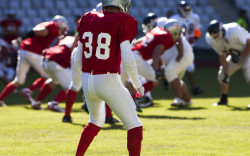Top Class Actions’s website and social media posts use affiliate links. If you make a purchase using such links, we may receive a commission, but it will not result in any additional charges to you. Please review our Affiliate Link Disclosure for more information.

The link between football and Chronic Traumatic Encephalopathy was first discovered in 2002 when researchers were studying the brain of football legend Mike Webster.
Over the last decade and a half, at least 50 more football players have been diagnosed at Boston University, with the youngest being a mere 17 years old.
Chronic Traumatic Encephalopathy been categorized into four stages of severity by pathologist Dr. Ann McKee. The brain changes appear to follow this distinct pattern when researchers looked to examine the brains of those who played football and suffered Chronic Traumatic Encephalopathy.
In the first stage, typically there are no symptoms that will overtly show the link between playing football and CTE, though brain changes may already become apparent.
When Chronic TraumaticEncephalopathy begins to affect an individual, the disease causes a protein to form around the blood vessels of the brain. This protein is known as tau and its works in the brain by interrupting its normal function and eventually killing nerve cells in the brain.
In the frontal lobe, located at the crown of the head, isolated spots of tau may begin to build up in the brain. This phenomenon may be seen on brain imaging.
In its second stage, more cells are affected by the tau protein in the brain’s frontal lobe. The relationship between football and Chronic Traumatic Encephalopathy becomes more apparent as outward signs and emotional symptoms are easily seen by those close to the affected individual.
This second stage of CTE is characterized by rage, depression and impulsivity. Individuals may lack the zest for life they once had and may blow up at those that they love. Spouses and those close to individuals affected may question if the football player has been involved in drugs or alcohol based on the changes in behavior seen.
By the third stage, more of the brain becomes affected by the tau proteins. Instead of just being confined to the frontal lobe of the brain, the tau proteins begin to affect the hippocampus as well as the amygdala. This causes confusion, memory loss and emotional disturbance.
In the final stage, the tau proteins have affected all parts of the brain. The brain nerve cells, or neurons, have been killed and the brain shrinks to about half of its normal size. The texture of the brain becomes deformed and feels brittle.
At this final stage, cognitive function has been severely impaired and the individual suffers from advanced dementia which is irreversible.
Football and Chronic Traumatic Encephalopathy
Anecdotally, there have been concerns about football and Chronic Traumatic Encephalopathy since before the term was even named. This is also the case in other sports where head injuries can occur.
Spouses, families, team members and coaches have witnessed such changes in certain athletes, but prior knowledge of CTE showed that only violent collisions were responsible. It was looked at as the “concussion crisis.”
Newer research showed that repeated head trauma on a smaller scale, not just large, violent collisions, were responsible for the brain damage seen. As a result, retired NFL players filed a lawsuit against the sports association regarding the relationship between football and Chronic Traumatic Encephalopathy (CTE).
The NFL reached a settlement with football players to provide testing, treatment and other monetary compensation to NFL players who have suffered CTE as a result of playing football.
Attorneys who have firsthand knowledge of the terms of the settlement say it is very complex and that retired NFL players who attempt to file a claim to receive compensation from the settlement must do so in a very particular way in order to access their full monetary award.
If you are a retired NFL player who may be eligible for a settlement over your career in football and Chronic Traumatic Encephalopathy, an experienced lawyer can review your case for free and can inform you of your options if you attempt to file a settlement claim.
Do YOU have a legal claim? Fill out the form on this page now for a free, immediate, and confidential case evaluation.
The attorneys who work with Top Class Actions will contact you if you qualify to let you know if you qualify to benefit from this NFL concussion settlement. Hurry — statutes of limitations may apply.
ATTORNEY ADVERTISING
Top Class Actions is a Proud Member of the American Bar Association
LEGAL INFORMATION IS NOT LEGAL ADVICE
Top Class Actions Legal Statement
©2008 – 2024 Top Class Actions® LLC
Various Trademarks held by their respective owners
This website is not intended for viewing or usage by European Union citizens.
Get Help – It’s Free
Join a Free NFL Concussion Settlment Investigation
If you qualify, an attorney will contact you to discuss the details of your rights at no charge to you.
Please Note: If you want to participate in this investigation, it is imperative that you reply to the law firm if they call or email you. Failing to do so may result in you not getting signed up as a client, if you qualify, or getting you dropped as a client.
Email any problems with this form to questions@topclassactions.com.
Oops! We could not locate your form.












